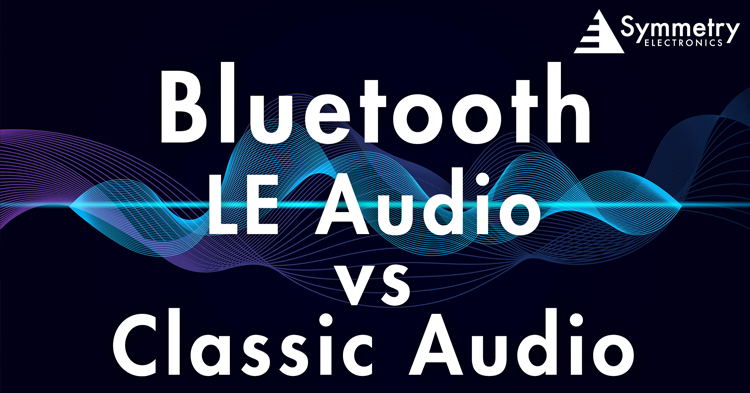- Home
- Symmetry Blog
- Bluetooth LE Audio vs. Classic Audio | Symmetry Blog
Bluetooth LE Audio vs. Classic Audio | Symmetry Blog
About Savannah Cuthbert

Released in January 2020 by the Bluetooth Special Interest Group (SIG), Low Energy (LE) Audio is the latest generation of Bluetooth audio–utilizing Bluetooth Low Energy (BLE) to offer product developers and consumers with the most advanced Bluetooth audio solution to date.
LE Audio is revolutionizing the way we utilize wireless headphones, headsets, speakers, voice assistants, smart phones, laptops, TVs, and more, with the ability to:
- Support the same products and use cases as the previous Bluetooth audio protocol, Classic Audio.
- Enable more advanced and complex use cases.
- Fuel the next 20 years of audio innovation.
LE Audio brings about four new key features that are changing the way we experience wireless audio, including its LC3 codec, the ability to multi-stream, advanced hearing aid support, and Broadcast Audio that enables Audio Sharing. Read along to find out how these features are changing the way we approach wireless listening and watching experiences, hands-free calling, and so much more.
LC3 Audio Codec
LE Audio includes a new high-quality, low power audio codec called the Low Complexity Communications Codec (LC3). According to the Bluetooth SIG, a codec is responsible for taking an uncompressed digital audio stream and compressing it down for transport over a Bluetooth wireless link, which is then uncompressed on the far end for playback. In comparison to the Subband codec (SBC) utilized by Classic Audio, LE Audio’s LC3 is capable of producing better audio quality when used at both the same data rate as the SBC and a lower data rate.
Multi-Stream Audio Support
Classic Audio can transport a single stream of audio between an audio source device such as a smart phone to an audio sink device such as headphones. In the case of wireless earbuds, Classic Audio is capable of transporting a single stream of audio from an audio source to one earbud and a second independent stream from the initial earbud to the other earbud. Conversely, LE Audio offers multi-stream audio support, which allows for a more optimized approach that produces a highly synchronized audio experience. Additionally, LE Audio can support multi-source scenarios such as the ability to connect wireless earbuds to both a smart phone and laptop simultaneously.
Advanced Hearing Aid Support
According to the World Health Organization, the number of people who suffer from hearing loss is continuing to increase across the globe. Bluetooth LE Audio hearing aids provide those with a hearing impairment with convenient low power, high quality, multi-stream, and location-based audio sharing capabilities.
Broadcast Audio and Audio Sharing
While Classic Audio utilizes a point-to-point communication topology, LE Audio is capable of utilizing both the point-to-point method and a new topology called Broadcast Audio. Perhaps the most impressive feature of LE Audio, Broadcast Audio “…[enables] an audio source device to broadcast one or more audio streams to an unlimited number of audio sink devices [at once]” (Bluetooth SIG). Broadcast Audio is available in both an open and closed format. With a closed broadcast, a passcode is required to connect an audio sink device to an audio source device.
Additionally, Broadcast Audio supports personal and location-based audio sharing. Personal audio sharing allows individuals to share a Bluetooth audio experience with others in the surrounding area. For example, an individual that is listening to music on their wireless headphones from their smart phone can allow a nearby friend or family member to connect their own wireless headphones to join in on the listening experience. On the other hand, location-based audio sharing allows public venues such as airports, bars, and movie theaters to offer attendees the ability to connect an audio sink device such as wireless earbuds or hearing aids to an audio source device such as a silenced TV for a high-quality, synchronized audio experience.
Conclusion
LE Audio utilizes Bluetooth LE to offer a low power, high quality audio solution for product developers and consumers. LE Audio’s new LC3 codec, multi-stream, advanced hearing aid support, and Broadcast Audio capabilities allows for design flexibility and an impressive, high-quality user experience.
